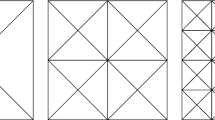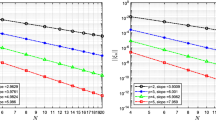Abstract
In this paper, the interpolating element-free Galerkin method is presented for the p-Laplace double obstacle mixed complementarity problem when \(1<p<2\) and \(p>2\). First, a nonlinear power penalty equation is obtained by a power penalty approximation method and the existence and uniqueness of the solution to the power penalty equation are proved when \(1<p<2\) and \(p>2\). The convergence of the power penalty solution to the original problem and the penalty estimates are analyzed. Second, the interpolating element-free Galerkin method is constructed for the nonlinear power penalty equation. The numerical implementation is introduced in detail and the convergence of the interpolating element-free Galerkin method is also given. Error estimates indicate that the convergence order depends on not only the spatial step h and the number of bases functions m in the interpolating element-free Galerkin method, but also the index k in the penalty term, the penalty factor \(\lambda \) and p. For different p, the method that how to choose the optimal k and \(\lambda \) is also given. Numerical examples verify error estimates and illustrate the influence of each parameter on the solution.
























Similar content being viewed by others
References
Ferris, M.C., Pang, J.S.: Engineering and economic applications of complementarity problems. SIAM Rev. 39(4), 669–713 (1997). https://doi.org/10.1137/S0036144595285963
Harker, P.T., Pang, J.S.: Finite-dimensional variational inequality and nonlinear complementarity problems: a survey of theory, algorithms and applications. Math. Program. 48(1–3), 161–220 (1990). https://doi.org/10.1007/bf01582255
Billups, S.C., Dirkse, S.P., Ferris, M.C.: A comparison of large scale mixed complementarity problem solvers. Comput. Optim. Appl. 7(1), 3–25 (1997). https://doi.org/10.1023/a:1008632215341
Forsyth, P.A., Vetzal, K.R.: Quadratic convergence for valuing American options using a penalty method. SIAM J. Sci. Comput. 23(6), 2095–2122 (2002). https://doi.org/10.1137/s1064827500382324
Gabriel, S.A.: An NE/SQP method for the bounded nonlinear complementarity problem. J. Optim. Theory Appl. 97(2), 493–506 (1998). https://doi.org/10.1023/a:1022643104274
Zhang, K., Wang, S.: Convergence property of an interior penalty approach to pricing American option. J. Ind. Manag. Optim. 7(2), 435–447 (2011). https://doi.org/10.3934/jimo.2011.7.435
Wang, S., Yang, X.Q., Teo, K.L.: Power penalty method for a linear complementarity problem arising from American option valuation. J. Optim. Theory Appl. 129(2), 227–254 (2006). https://doi.org/10.1007/s10957-006-9062-3
Chen, Q., Chu, D., Tan, R.C., Ye, Y.: Double obstacle control problem for a quasilinear elliptic variational inequality with source term. Nonlinear Anal. Real World Appl. 18, 108–120 (2014). https://doi.org/10.1016/j.nonrwa.2014.01.007
Glowinski, R., Lions, J.L., Trémolières, R.: Numerical Analysis of Variational Inequalities. Elsevier North-Holland, Amsterdam (1981)
Zhou, Z., Peng, Y.: The locally Chen–Harker–Kanzow–Smale smoothing functions for mixed complementarity problems. J. Global Optim. 74(1), 169–193 (2019). https://doi.org/10.1007/s10898-019-00739-4
Barrett, J.W., Liu, W.: Quasi-norm error bounds for the finite element approximation of a non-Newtonian flow. Numer. Math. 68(4), 437–456 (1994). https://doi.org/10.1007/s002110050071
Jouvet, G., Bueler, E.: Steady, shallow ice sheets as obstacle problems: well-posedness and finite element approximation. SIAM J. Appl. Math. 72(4), 1292–1314 (2012). https://doi.org/10.1137/110856654
Barrett, J.W., Liu, W.B.: Finite element approximation of the \(p\)-Laplacian. Math. Comput. 61(204), 523–537 (1993). https://doi.org/10.1090/s0025-5718-1993-1192966-4
Banz, L., Lamichhane, B.P., Stephan, E.P.: Higher order FEM for the obstacle problem of the \(p\)-Laplacian—a variational inequality approach. Comput. Math. Appl. 76(7), 1639–1660 (2018). https://doi.org/10.1016/j.camwa.2018.07.016
Ebmeyer, C., Liu, W.: Quasi-norm interpolation error estimates for the piecewise linear finite element approximation of \(p\)-Laplacian problems. Numer. Math. 100(2), 233–258 (2005). https://doi.org/10.1007/s00211-005-0594-5
Oberman, A.M.: Finite difference methods for the infinity Laplace and \(p\)-Laplace equations. J. Comput. Appl. Math. 254, 65–80 (2013). https://doi.org/10.1016/j.cam.2012.11.023
Duan, Y., Wang, S., Zhou, Y.: A power penalty approach to a mixed quasilinear elliptic complementarity problem. J. Global Optim. 81(4), 901–918 (2021). https://doi.org/10.1007/s10898-021-01000-7
Zhou, Y.Y., Wang, S., Yang, X.Q.: A penalty approximation method for a semilinear parabolic double obstacle problem. J. Global Optim. 60(3), 531–550 (2013). https://doi.org/10.1007/s10898-013-0122-6
Kim, K.Y.: Error estimates for a mixed finite volume method for the \(p\)-Laplacian problem. Numer. Math. 101(1), 121–142 (2005). https://doi.org/10.1007/s00211-005-0610-9
Cockburn, B., Shen, J.: A hybridizable discontinuous Galerkin method for the \(p\)-Laplacian. SIAM J. Sci. Comput. 38(1), A545–A566 (2016). https://doi.org/10.1137/15m1008014
Ding, R., Shen, Q., Zhu, Z.: Convergence analysis and error estimates of the element-free Galerkin method for a class of parabolic evolutionary variational inequalities. Comput. Math. Appl. 75(1), 22–32 (2018). https://doi.org/10.1016/j.camwa.2017.08.031
Ding, R., Wang, Y., Shen, Q.: Convergence analysis and error estimates of the element-free Galerkin method for the second kind of elliptic variational inequalities. Comput. Math. Appl. 78(8), 2584–2592 (2019). https://doi.org/10.1016/j.camwa.2019.03.059
Shen, Q., Ding, R., Wang, Y.: Error estimates for a contact problem with the Tresca friction or the simplified coulomb friction in elastic materials by the element-free Galerkin method. Appl. Math. Model. 77, 690–708 (2020). https://doi.org/10.1016/j.apm.2019.07.052
Dehghan, M., Narimani, N.: An element-free Galerkin meshless method for simulating the behavior of cancer cell invasion of surrounding tissue. Appl. Math. Model. 59, 500–513 (2018). https://doi.org/10.1016/j.apm.2018.01.034
Zhang, T., Li, X., Xu, L.: Error analysis of an implicit Galerkin meshfree scheme for general second-order parabolic problems. Appl. Numer. Math. 177, 58–78 (2022). https://doi.org/10.1016/j.apnum.2022.03.005
Lancaster, P., Salkauskas, K.: Surfaces generated by moving least squares methods. Math. Comput. 37(155), 141–158 (1981). https://doi.org/10.1090/s0025-5718-1981-0616367-1
Ren, H., Cheng, Y.: The interpolating element-free Galerkin (IEFG) method for two-dimensional potential problems. Eng. Anal. Boundary Elem. 36(5), 873–880 (2012). https://doi.org/10.1016/j.enganabound.2011.09.014
Liu, D., Cheng, Y.: The interpolating element-free Galerkin (IEFG) method for three-dimensional potential problems. Eng. Anal. Boundary Elem. 108, 115–123 (2019). https://doi.org/10.1016/j.enganabound.2019.08.021
Dehghan, M., Abbaszadeh, M.: Error analysis and numerical simulation of magnetohydrodynamics (MHD) equation based on the interpolating element free Galerkin (IEFG) method. Appl. Numer. Math. 137, 252–273 (2019). https://doi.org/10.1016/j.apnum.2018.10.004
Shen, Q., Ding, R., Zhu, Z.: Convergence analysis and error estimates of the interpolating element-free Galerkin method for the evolutionary variational inequality of the second-order in time. Comput. Appl. Math. 39(2), 130 (2020). https://doi.org/10.1007/s40314-020-01154-2
Liu, F., Wu, Q., Cheng, Y.: A meshless method based on the nonsingular weight functions for elastoplastic large deformation problems. Int. J. Appl. Mech. 11(01), 1950006 (2019). https://doi.org/10.1142/S1758825119500066
Wu, Q., Peng, P., Cheng, Y.: The interpolating element-free Galerkin method for elastic large deformation problems. Sci. China Technol. Sci. 64, 364–374 (2021). https://doi.org/10.1007/s11431-019-1583-y
Liu, D., Cheng, Y.: The interpolating element-free galerkin method for three-dimensional transient heat conduction problems. Results Phys. 19, 103477 (2020). https://doi.org/10.1016/j.rinp.2020.103477
Wu, Q., Peng, M., Fu, Y., Cheng, Y.: The dimension splitting interpolating element-free Galerkin method for solving three-dimensional transient heat conduction problems. Eng. Anal. Boundary Elem. 128, 326–341 (2021). https://doi.org/10.1016/j.enganabound.2021.04.016
Mirzaei, D., Dehghan, M.: MLPG approximation to the \(p\)-Laplace problem. Comput. Mech. 46(6), 805–812 (2010). https://doi.org/10.1007/s00466-010-0521-1
Li, X., Dong, H.: The element-free Galerkin method for the nonlinear p-Laplacian equation. Comput. Math. Appl. 75(7), 2549–2560 (2018). https://doi.org/10.1016/j.camwa.2017.12.019
Li, X., Li, S.: Analyzing the nonlinear \(p\)-Laplacian problem with the improved element-free Galerkin method. Eng. Anal. Bound. Elem. 100, 48–58 (2019). https://doi.org/10.1016/j.enganabound.2018.04.004
Tatari, M., Kamranian, M., Dehghan, M.: The finite point method for the \(p\)-Laplace equation. Comput. Mech. 48(6), 689–697 (2011). https://doi.org/10.1007/s00466-011-0613-6
Lewicka, M., Manfredi, J.J.: The obstacle problem for the \(p\)-Laplacian via optimal stopping of tug-of-war games. Probab. Theory Relat. Fields 167(1–2), 349–378 (2015). https://doi.org/10.1007/s00440-015-0684-y
Wang, S., Huang, C.-S.: A power penalty method for solving a nonlinear parabolic complementarity problem. Nonlinear Anal. Theory Methods Appl. 69(4), 1125–1137 (2008). https://doi.org/10.1016/j.na.2007.06.014
Sun, F., Wang, J., Cheng, Y., Huang, A.: Error estimates for the interpolating moving least-squares method in n-dimensional space. Appl. Numer. Math. 98, 79–105 (2015). https://doi.org/10.1016/j.apnum.2015.08.001
Wang, J., Wang, J., Sun, F., Cheng, Y.: An interpolating boundary element-free method with nonsingular weight function for two-dimensional potential problems. Int. J. Comput. Methods 10(06), 1350043 (2013). https://doi.org/10.1142/S0219876213500436
Li, X.: Error estimates for the moving least-square approximation and the element-free Galerkin method in n-dimensional spaces. Appl. Numer. Math. 99, 77–97 (2016). https://doi.org/10.1016/j.apnum.2015.07.006
Wan, J., Li, X.: Analysis of a superconvergent recursive moving least squares approximation. Appl. Math. Lett. 133, 108223 (2022). https://doi.org/10.1016/j.aml.2022.108223
Huang, C., Wang, S.: A power penalty approach to a nonlinear complementarity problem. Oper. Res. Lett. 38(1), 72–76 (2010). https://doi.org/10.1016/j.orl.2009.09.009
Liu, W., Yan, N.: Quasi-norm local error estimators for \(p\)-Laplacian. SIAM J. Numer. Anal. 39(1), 100–127 (2001). https://doi.org/10.1137/s0036142999351613
Author information
Authors and Affiliations
Corresponding author
Additional information
Publisher's Note
Springer Nature remains neutral with regard to jurisdictional claims in published maps and institutional affiliations.
This work was supported by the National Natural Science Foundation of China (Nos. 11401416 and 11771319).
Rights and permissions
Springer Nature or its licensor (e.g. a society or other partner) holds exclusive rights to this article under a publishing agreement with the author(s) or other rightsholder(s); author self-archiving of the accepted manuscript version of this article is solely governed by the terms of such publishing agreement and applicable law.
About this article
Cite this article
Ding, R., Ding, C. & Shen, Q. The interpolating element-free Galerkin method for the p-Laplace double obstacle mixed complementarity problem. J Glob Optim 86, 781–820 (2023). https://doi.org/10.1007/s10898-022-01260-x
Received:
Accepted:
Published:
Issue Date:
DOI: https://doi.org/10.1007/s10898-022-01260-x




